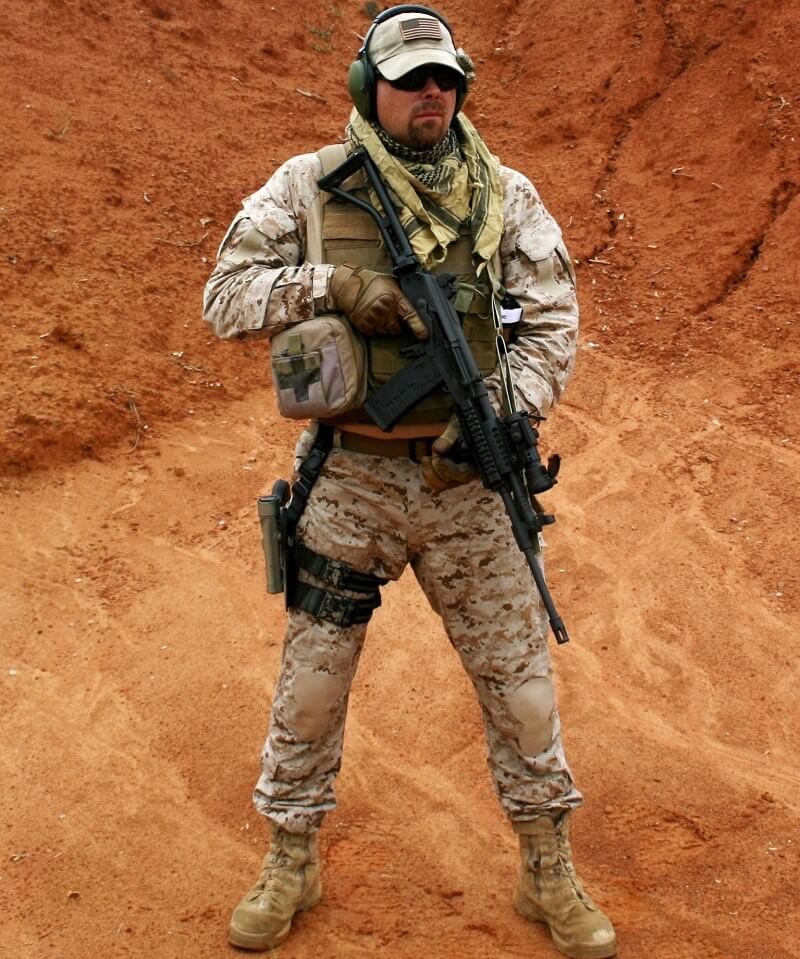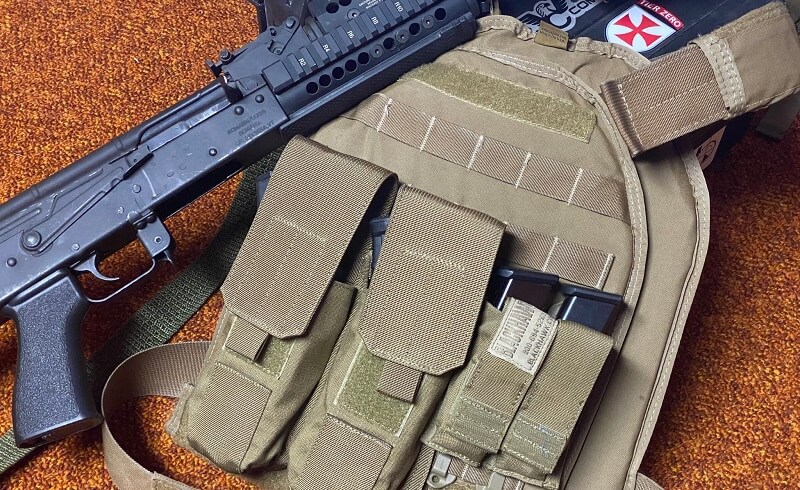Navigate This Post
If you are one of the tens of thousands of citizens who owns and carries a firearm for personal protection you’ve likely accepted the fact that bad things can, and do, happen to good people. You’ve adjusted your manner of dress and lifestyle to accommodate toting your chosen type of hardware. Carrying a gun every day definitely takes some adjustment. Have you taken the leap into the world of body armor though?
As someone who has worn armor, both concealed and external for over thirty years, I can tell you one thing: wearing armor sucks. Armor makes you sweat, even in cold weather. It’s heavy and constantly rubs you the wrong way. Granted, it doesn’t suck as bad as it did when I was a USMC Private or a rookie police officer. Armor technology and carriers have definitely improved over the last couple of decades.
Comfort, however, is relative. When I was with the 6th Marines laying in a shallow ditch with artillery shells screaming overhead and incoming mortars exploding far too closely, my flak jacket and helmet were pretty darn comforting. Later in life, while searching a darkened building for possible suspects, I felt a bit more comfort in knowing that my Level IIIA armor vest with a hard plate covering my heart was under my polyester uniform shirt. Armor, like insurance or your gun, is an item that you are glad to have “just in case” things don’t go your way.

The author wore an external hard plate carrier during his time as a Military Contractor.
Paranoid or Prepared? – Body Armor and You.
Help us combat Censorship by joining our Newsletter
I can think of a number of reasons why a citizen might want the extra bit of comfort that soft body armor provides. Any merchant who deals in cash or valuables like gold or jewelry is, by profession, in a precarious occupation. A home invasion, where the police are fifteen minutes away but the gang-bangers at your front door are seconds away, is another reason for armor. We also have the ugly but very realistic scenarios of civil unrest, as seen throughout all of 2020.
We can’t always predict what tomorrow might bring. It’s easy to talk yourself out of being prepared to face evil because evil isn’t always in your face. However, evil is always present, like it or not. Purchasing body armor doesn’t make you paranoid. It makes you prepared for whatever life might throw at you.
Choices: Hard Armor vs. Soft Armor.
First of all, there is no such thing as a “bullet-proof” vest. For every type and style of armor available, there is a projectile that will penetrate it. However, there are multiple levels or layers of bullet-resistant armor. The National Institute of Justice created a “Level” rating for armor. Soft armor is rated from Level IIA up to IIIA and hard armor is either Level III or IV.
What’s more important is to discuss what armor is available to you. When it comes to wearable armor you have hard and soft as well as concealable and external. Soft body armor is generally a panel of some shape made from a pliable, flexible material. DuPont’s Kevlar® is the most commonly used material, though there are others.
Hard armor takes the form of inflexible plates, again, made in various shapes and sizes. The material used to make hard armor plates varies from hardened steel covered in nylon or rubber to some type of hardened/reinforced ceramic. Again, even today materials are being invented to create new types of armor.
Soft armor is relatively light and, because it is flexible, can be wrapped around a human torso. Hard armor is strategically placed over the front and back of the torso to shield vital organs.
The rub is that soft armor is only capable of stopping low velocity projectiles to include handgun bullets, shotgun pellets, and fragmentation from explosions. Hard armor is capable of stopping all the aforementioned threats, but it can also defeat high velocity projectiles from rifles and shotgun slugs. Yes, there are projectiles with steel/tungsten cores that will penetrate hard armor, but let’s stick to the basics here.
Concealable or External Body Armor Carriers.
Both hard and soft armor can be concealed or worn in covert or external carriers. The benefit of concealable armor, naturally, is that it doesn’t stand out or draw attention to the wearer. The downside is that it requires some effort to put on, and can be less than comfortable.
External armor carriers, for both hard and soft armor, are obvious, but also far more utilitarian. Overt carriers can be outfitted with a variety of pouches to tote myriads of gear including spare ammunition, medical gear, a handgun, phones and radios, etc. Overt armor carriers generally are easy to don and can be put on quickly in an emergency.
Which armor carry method is the best? It depends on your circumstance. A gold dealer walking around in a big city would naturally be better served by a concealed vest. The homeowner who wants armor they can throw over their body in an emergency isn’t worried about being discreet. What is your purpose for the armor? That is the question you need to ask yourself before making the purchase.
Concealable Body Armor Makers.
SAFARILAND.
When I was a young police officer, my first vest came from Second Chance. That company was purchased many years ago and folded into Safariland. Safariland makes a wide variety of concealable, soft armor carriers as well as overt carriers for both hard and soft armor.
US ARMOR
When I was working as an executive protection agent in the 1990’s, I had to purchase my own vest to wear under civilian clothes. The vest I bought came from US Armor and it was their “Enforcer” model Level II. I wore that “vest” for many years all over the United States on bodyguard assignments.
SAFE LIFE DEFENSE
In the interest of full disclosure, I have not worn the products from Safe Life Defense. They do seem to have a good reputation and their product line is extensive. Any company that has an “NIJ” rating must pass rigorous testing. I can say that I appreciated the easy to use size calculator on their website.

Hard armor, plate carrier with AR500 plates configured for AK magazines.
External Hard Body Armor Makers.
AR500 BODY ARMOR
First of all, everyone and their brother is making “plate carriers” today. The stitched nylon carrier is the easy part, the plates are the hard part. I have about three years worth of experience with the AR500 Armor company. I can tell you that they have a stellar reputation and that I have never been disappointed by their products. AR500 Armor makes Level III and IV plates in a variety of configurations. Naturally, they make quality plate carriers to go with their armor plates.
SHOT STOP
My friend and fellow collaborator, Josh Brooks, recently reviewed a new armor plate maker; Shot Stop. Josh, being a combat-decorated US Marine infantryman during the latest unpleasantness, has worn his fair share of armor and plates. Josh wrote a detailed review of the new Duritium® armor material that Shot Stop is using to make plates that stop high powered rifle rounds.
We also had a fellow member of the Student of the Gun family recently review these same plates. Robert had absolutely nothing negative to say about them. You can check out that review here.
BREAKING NEWS
Our friends at Brownells just sent out a promotional email as this article was going to the printer. Brownells has a variety of armor plates and plate carriers in stock as of press time. Take a look.
How valuable is your life?
Much of the push-back from our side of the aisle when it comes to citizen ownership of soft body armor stems from the “reasonableness disease”. I’ve been party to conversations with gun owners where the topic of body armor came up. One person opined, “Civilians don’t need that (armor), it’s best left for police and the military. I mean, how paranoid are you?”
That statement says that the speaker believes three (3) things: 1) the life of someone in a uniform is more valuable than that of a citizen. 2) working for a government agency bestows special rights not afforded to the citizenry. 3) the person making the statement has no understanding of what a violent assault entails.
At the end of the day, you need to decide what is best for you and your family. Is owning body armor “too much” or “paranoid”? Or, is armor just one more prudent step toward self-preservation? The choice is up to you. Choose wisely.
Professor Paul Markel
Latest posts by Professor Paul Markel (see all)
- Tactical Masturbation: Top 3 Stupid Human Tricks - July 8th, 2024
- Blood Trail: Fearless Fiction - June 21st, 2024
- SOTG and SB Tactical Celebrate Brace Ruling - June 20th, 2024
- Shotgun Accessories: Practical and Useful - June 14th, 2024
- Tactical Rifle Tips: Transition Drills - January 5th, 2024






Thank you for the information, I appreciate it!
Sure thing. Thanks for reading. We talk more in depth about armor on episode 1,008 of Student of the Gun Radio. Be sure to subscribe.
Great information. The timing was perfect. I just purchased “The Freeman” from AR500. Next step is a full rig. Looking at the Veritas setup.
I have the Veritas setup. I like it a lot.
For Church security and Executive protection I have worn a couple of brands of “hidden” armor. For the last couple of years I have worn the AR600 concealment armor (https://www.ar500armor.com/ar-concealment.html) it has less of a ‘print’ than what I used to wear (safe light) which was still great.
If we are in a high threat situation, I have my client(s) wear a Bullet Safe vest during movement.